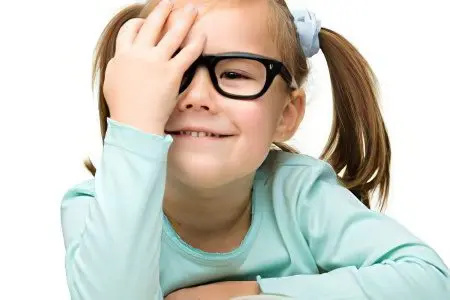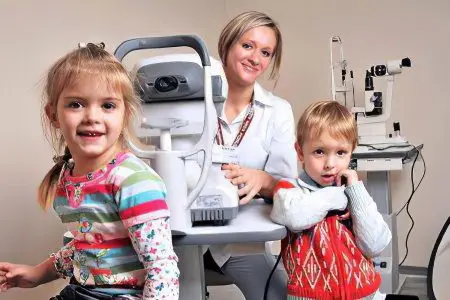Contents
 Myopia of the eye – causes, symptoms, degrees and treatment
Myopia of the eye – causes, symptoms, degrees and treatment  Myopia 1 weak degree
Myopia 1 weak degree Myopia 2 moderate
Myopia 2 moderate Myopia 3 high degree
Myopia 3 high degree Myopia during pregnancy
Myopia during pregnancy
What is progressive myopia?

Progressive myopia in children is a complex multifactorial disease, originating in childhood and characterized by impaired focus. This violation lies in the fact that, normally, the focusing of the rays refracted by the lens of the eye should fall on the retina, and with myopia, it is located in front of it. The distance, which characterizes the degree of visual impairment, is calculated in diopters. Progressive is a disease in which visual impairment occurs by 1 or more diopters per year.
According to statistics, up to 30% of all children suffer from myopia, and older preschoolers and younger schoolchildren are more likely to experience a progressive form of the disease.
Symptoms of progressive myopia in children
Among the symptoms characteristic of progressive myopia, the following can be distinguished:
Decreased visual acuity when looking into the distance, which gradually increases.
Squinting of the eyes.
Gritting of teeth, holding the breath, tension of all facial and eye muscles when trying to examine an object.
Increasing levels of anxiety in children. It is not difficult to notice this, it is expressed in the sucking of fingers, pens, pencils when performing visual work.
Formation of the habit of keeping the head in a slightly bent position.
Asthenic physique.
Wide palpebral fissure, which increases due to the growing eyeball.
Stretching of the vascular and retinal membranes of the eye.
An increase in the number of conjunctivitis and blepharitis due to chronic tension in the muscles of the eyes when squinting.
Narrowing of the field of view.
Causes of progressive myopia in children
There are many reasons that indirectly affect the development of myopia in childhood, these are traumatic brain injuries, prematurity, frequent infectious diseases, and unfavorable environmental conditions in the region of residence, etc.
However, there are four basic links that have a significant impact on the pathogenesis of progressive myopia in childhood:
Hereditary predisposition. Myopia is inherited from parents in two ways: autosomal dominant and autosomal recessive. If inheritance occurred according to the first type, then the disease will appear at an older age and will not reach a high degree. If inheritance has occurred according to a recessive type, then the risk of complications and rapid progression of myopia increases, in addition, myopia appears at an earlier age.
Visual work combined with weakness of accommodation. If a child reads a lot, writes, sits at a computer and otherwise loads his eyesight at close range, then this leads to a weakening of accommodation. The organism changes the optics of the eyes in the ways possible for it, adjusting it to the conditions that have arisen. He does this primarily by lengthening the axis of the eye, which is especially dangerous during the period of its formation and active growth. This leads to the development of progressive myopia in childhood.
Weakness of accommodation, due to the fact that the ciliary muscle was morphologically defective from birth, or with the negative impact of general diseases (ARVI, influenza, scarlet fever, measles, tuberculosis, meningitis, etc.).
Weakening of the eye sclera under the influence of intraocular pressure. The development of progressive myopia in childhood is largely influenced by the dynamic pressure that occurs with any movements of the head and trunk. If it is slightly increased, the intraocular fluid increases pressure on the back wall of the eye, deforming it, thereby creating prerequisites for the development of myopia.
There is another type of progressive myopia in children – this is the so-called adaptive myopia, which manifests itself and intensifies only during the intensive growth of the child.
Treatment of progressive myopia in children

It is important to understand that the initial goal of treatment is not to eliminate myopia, but to stop or slow down its progression, as it helps to prevent complications.
Glasses. To correct the vision of children with myopia, glasses are used, which must be selected individually. If in the case of stationary myopia an incomplete correction is used, then with a progressive disease, a complete correction is necessary for viewing objects at a distance and incomplete for close distances.
Quasi-optical glasses. An effective and modern way to correct myopia in childhood is to wear quasi-optical glasses. They stimulate vision, do not require constant wear, increase the efficiency of the visual apparatus, protect against x-ray, ultraviolet and other types of radiation, and also have a number of other advantages. Therefore, the use of quasi-optical glasses in pediatric ophthalmology is justified and expedient.
However, progressive childhood myopia requires not only correction, but also treatment. To achieve this goal, there are surgical and conservative methods that can be combined:
Eye training. As for conservative methods of treating progressive childhood myopia, these include training the accommodation apparatus on special devices, gymnastics for the eyes, reflexology, and stimulating it with a laser. Pneumomassage has a positive effect on the course of the disease in childhood.
Scleroplasty. Scleroplasty, which is aimed at strengthening the posterior wall of the eyeball, can be attributed to surgical methods of treatment in childhood.
Compliance with the regime of visual work is a pathogenetic therapeutic factor in childhood. If progressive myopia is detected, it is necessary to reduce visual loads, and every 25 minutes to give the eyes a rest. It is important to control the child’s pastime at the computer. So kids under 3 years old should not be allowed to use it at all. Before entering school, the child should not be behind him for more than 15 minutes a day. Subsequently, the time increases and for high school students it averages an hour with breaks.
Author of the article: Degtyareva Marina Vitalievna, ophthalmologist, ophthalmologist









